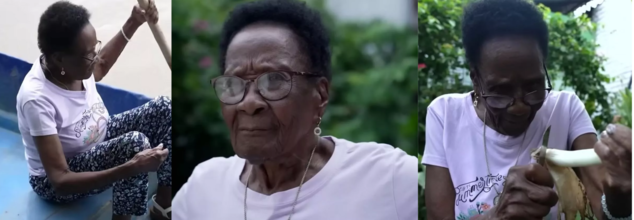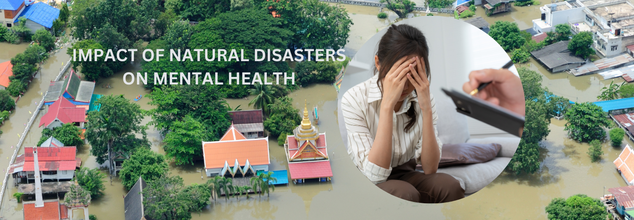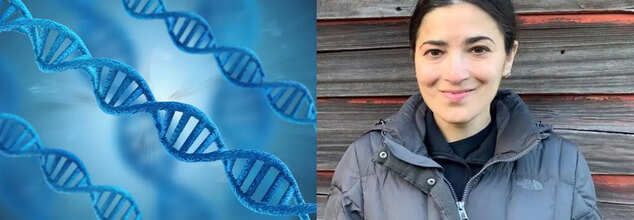- Health Conditions A-Z
- Health & Wellness
- Nutrition
- Fitness
- Health News
- Ayurveda
- Videos
- Medicine A-Z
- Parenting
- Web Stories

Credits: Youtube
123-Year-Old Woman Credits Two Everyday Foods Behind Her Unbelievable Longevity
In a world where superfoods, supplements, and scientific advances define the health discourse, María Antonia Cuero's story shines for its elegant simplicity. At 123, María is officially the world's oldest living human—informally surpassing the Guinness World Record holder, France's Jeanne Louise Calment, who reached 122 years of age. Though her age remains in process of verification, the insights she offers are incontrovertibly priceless and scientifically validated.
Born on October 18, 1901, in Colombia, María has witnessed two world wars, numerous technological revolutions, and the dawn of modern medicine. Yet when asked what the secret to her remarkable longevity is, María doesn't refer to a magic pill or a genetic mutation. Rather, she attributes her longevity to two humble foods: fish and bananas—cornerstones of her daily diet, steeped in her coastal upbringing.
Growing up in a big family of 10 siblings by the Mayorquín River, María spent her days surrounded by nature. With fresh fish and tropical fruits readily available, her childhood diet was both organic and full of nutrients—years before these words became health buzzwords. Throughout the decades, she also raised eight children and is now the proud matriarch to 26 grandchildren, 24 great-grandchildren, and 54 great-great-grandchildren.
Although not officially documented by the Guinness World Records, María's identification card in 2012 indicates her birth as October 1901. She became the oldest to get vaccinated in March 2021, at 119 years old, marking yet another incredible achievement to her name.
However, aside from age and figures, it is María's way of living and attitude that provide deep insights into longevity.
Maria's Mindset and Philosophy of Longevity
In an interview on the Colombian television show Los Informantes, María discussed her philosophy of life: laugh frequently, don't worry excessively, remain active, and don't sit around too much. In her opinion, physical activity is essential. Her regimen included walking often, swimming, rowing, and being outdoors—long before fitness monitors or gym memberships were the rage.
These principles echo research in contemporary gerontology. Many studies identify an active life and good social relationships with a lower risk of chronic disease and longer lifespan. María's case supports that emotional well-being, combined with activity, is significant in healthy aging.
Fish
Of all the foods that she ate, fish is what María puts so much stress on. Living next to the river as a child, not only was she afforded the fresh catches each day, but she fished herself very frequently. "Good fish. I would fry the fish and then mix it with coconut and rice," she shared with a journalist.
Fish is a good source of high-quality protein, omega-3 fatty acids, vitamins D and B2 (riboflavin), and minerals like calcium, phosphorus, iron, zinc, iodine, magnesium, and potassium. Omega-3s in oily fish, particularly docosahexaenoic acid (DHA), are recognized to lower inflammation, maintain brain health, and decrease the risk of heart disease.
Scientific studies in the Journal of the American Medical Association have indicated that individuals with high levels of omega-3s live as much as 2.5 years longer on average. Another significant study identified a 40% lower risk of coronary heart disease mortality in those who ate regularly from fish with high levels of omega-3s, a figure further supported by the British Heart Foundation.
Bananas
María's second pillar of diet? Bananas—the smaller, sweeter bocadillo bananas (also referred to as sugar bananas or lady finger bananas). These bite-sized fruits are not only tasty but are full of fiber, antioxidants, potassium, and vital vitamins.
Bananas have been valued for centuries for their digestive and cardiovascular benefits. They help to control blood pressure, balance body fluids, and repair muscle and nerve tissue—all highly beneficial for elderly populations. The tryptophan and vitamin B6 contained in bananas also assist with serotonin formation, the "feel-good" neurotransmitter that enhances emotional well-being.
For María, these bananas were an everyday treat. And as science indicates, eating bananas on a regular basis can help with heart health, boost mood, and assist with muscle recovery.
What We Can Learn From Her Habit?
María's remarkable life is not merely about what she ate—it's about the regularity with which she lived. Her life was based on balance: a modest diet, regular exercise, a positive attitude, and close family ties. To this day, she radiates resilience. When asked what she is afraid of, her answer was moving: "I am not afraid of anything anymore."
This lack of fear and deeply ingrained calmness may also have protective health benefits. Studies have linked chronic stress to increased inflammation and a heightened risk of age-related diseases. María’s philosophy—“don’t worry too much”—may offer more protection than we’ve previously realized.
As the world population ages, María Antonia Cuero's life is an eloquent reminder: the route to longevity may not come in the form of costly therapies, restrictive eating, or vigilant self-tracking. It may sometimes be found in age-old secrets—eat fresh, move frequently, laugh without restraint, and enjoy the little things.
As we wait for official verification of her record-setting age, her legacy already walks tall as an example of how simplicity, persistence, and culture can overcome and thrive. In a world filled with constantly changing health fads, María's legacy encourages us to stop for a moment and ask—what really counts when it comes to living a long, healthy life?

(Credit-Kidney Cancer UK TikTok)
Vague Symptoms Of This Deadly Disease Caused Woman To Mistake It For Menopause
Misleading signs are often worse than no signs, you may be working on the symptoms when the disease is already doing damage to your body. When something goes wrong in our body, most of us can catch onto it. However, we almost always tackle the most obvious issue, not knowing there could be something worse going on.
A similar issue happens to a UK-based woman, named, Loise who was suffering with high blood pressure and dismissed it as a symptom of menopause. Soon she found out that it was in fact not menopause that she was going through, rather she had been battling kidney cancer and did not know about it.
Cancer is the leading cause of death worldwide with nearly 10 million deaths in 2020. Cancer is a generic term for many different diseases that affect parts of one's body, according to the World Health Organization. Kidney cancer is the sixth most common cancer in UK adults and 14th most common cancer worldwide. According to Cancer Research UK, the average number of cases reported for kidney cancer in 2017-19 UK was 13,834. It is also more common in the elderly, aged 80-84, and there has been a 92% rise in the incidence rates of kidney cancer since the 1990s.
Misleading Symptoms and Important Warnings
In the Kidney Cancer UK's TikTok page, Louise's highlights the critical importance of recognizing that not all symptoms in middle-aged women are solely due to hormonal changes. In her case, the elevated blood pressure was an indicator of an aggressive form of kidney cancer.
Often, kidney cancer doesn't manifest with clear and distinct symptoms, and it is frequently discovered incidentally during tests conducted for other health concerns. Louise emphasized the challenge of diagnosis, "Symptoms are unfortunately vague, especially for women, as it includes high blood pressure, night sweats, blood in your urine and flank pain. GPs often relate these to menopause symptoms." She strongly advises everyone to "regularly scan your body" and to pay attention to persistent discomfort. She urged, "How long have those niggling pains been there? Get them checked - always better to be safe than sorry!"
What To Expect After The Diagnosis?
Reflecting on her own diagnosis, Louise recounted having "high blood pressure but unseen blood" in her urine. She explained how her cancer was detected, "I was lucky routine bloods picked up an issue with my liver, prompting ultrasound."
Her treatment journey involved significant surgical interventions, "I have now had two major surgeries to remove cancer and my kidney within the last 15 months. I'm three weeks post open surgery and recovering well." The outcome of recent tests brought encouraging news, "The news that all the biopsies came back as not cancer has been amazing."
Currently, Louise is managing side effects from her immunotherapy treatment. Looking ahead, Louise remains realistic but hopeful "My cancer was the most aggressive at grade 4 so there will always be a high chance of it coming back, but medications and research is changing all the time and I have faith that the surveillance scans will help us nip anything untoward in the bud!"
Kidney Cancer Symptoms You Should Look Out For
While kidney cancer often progresses without noticeable symptoms, the NHS indicates that when they do appear, they can include:
- Blood in your pee
- A lump or swelling in your back, under your ribs, or in your neck
- Persistent pain between your ribs and waist
- Unexplained loss of appetite or weight loss
- Persistent fatigue or lack of energy
- A recurring high temperature
- Excessive sweating, particularly at night

Credits: Canva
Can Natural Disasters Impact Your Mental Health? Here's What Experts Say
Throughout the first week of April, the state of Kentucky witnessed flooding, due to heavy rains, specifically in the Franklin County. The reason being, it is located on the Kentucky River for over 200 years. While such natural disasters can cause distress in terms of physical safety, expert also reveals that such natural disasters could impact one's mental health too.
Natural disasters like Kentucky's recent flooding can have serious impacts on victim's mental health, reveals Christal Badour, associate professor of psychology at the University of Kentucky and a trauma recovery research.
As reported in Weku NPR, the UK psychologist explains that reactions to traumatic events typically fall into short-term and long-term symptoms. These include people feeling overwhelmed, anxiety, and difficulty communicating. While most people eventually recover without lasting effects, some may struggle for a longer duration.
These long-term issues include depression or post-traumatic stress disorder (PTSD). Badour also notes that people who already had a mental health difficulty before the natural disaster could also further feel isolated. Along with that, individuals with fewer financial resources could be at more risk of long-term problems.
Are These Long-term Symptoms Common?
According to a report from Clinical Psychology Review, 20 to 80% of people will experience long-term symptoms after a disaster. These rates could vary depending on the type of disaster one faces. PTSD symptoms often improve after the first year, however, depression and anxiety are more likely to linger.
What Do Other Experts Say?
There have been previous studies too that confirm the same. As per a 2024 study, titled Impact of Natural Disasters on Mental Health: Evidence and Implications, by Eamin Z Heanoy and Norman R Brown, notes: "Natural disasters are large-scale catastrophic events, and they are increasing in frequency and severity. Converging evidence indicates that the mental health consequences of disasters are extensive and are often associated with trauma and the disruption of personal and socioeconomic factors in people’s lives."
However, the study also notes that although most individuals who experience disaster-related traumatic events do not develop mental illnesses, some could experience adverse psychological effects of the disaster.
Another expert, Nomy Levy-Carric, MD, MPhil, writes for Mass General Brigham, which is an institute dedicated to serving the community and enhancing patient care, teaching, and research, notes that natural disaster can indeed leave a lasting impact on individuals, families, and often an entire community.
Levy Carrick notes: "A person’s reaction depends on many factors, including their past experiences, what is happening in their life at that moment, the nature of their exposure, and the support available to them as they rebuild. The sudden loss of control and uncertainty can be overwhelming, making it harder to cope in both the short and long term."
What Are The Types Of Natural Disasters?
- Hurricanes and tropical storms
- Earthquakes
- Tornadoes
- Wildfire
- Floods
- Blizzards and winter storms
- Drought and extreme heat
- Landslides and mudslides
The doctor notes the Psychological First Aid or PFA provides a structured way to support emotional recovery immediately after a disaster.
However, notes Badour, there is still a major gap in treatment. Most disaster relief services only last up to one year.
“After that year has passed, a lot of people feel like there's no one there to help them, especially if you're in a community that was already lacking in mental health support and resources,” she said.

Credits: Canva and (R) Emily Kramer-Golinkoff (AP)
Living With A Rare Genetic Mutation: Advanced Cystic Fibrosis
Emily Kramer-Golinkoff, 40, today struggles to take in enough oxygen with each breath. She is living with advances cystic fibrosis, which makes simple activities like walking or showering, exhausting for her. She is one of the 40,000 Americans who are affected and are living with the most common fatal genetic disease in the United States.
As per the National Heart, Lung, and Blood Institute, cystic fibrosis is a genetic condition that changes a protein in the body. The faulty protein then affects the body's cells, tissues, and the glands that make mucus and sweat. Cystic fibrosis cause mucus to become thick and sticky. As a result, it builds up and causes blockages, damages, or infections.
While most are born with this condition and continue to be on the medication throughout, for Kramer-Golinoff's rare genetic mutation cannot be managed by the same medication that help about 90% of cystic fibrosis patients.
"For our friends who have been lifting from the sinking ship, we feel such pure joy. But we just feel so eager and desperate to join them. It is really hard to be in this minority of people left behind," Kramer-Golinoff told the Associated Press (AP).
Rare Mutation And Its Challenges
The gap between patients with common and rare mutations is a growing concern. Advances in genetic science have uncovered the precise causes behind many brutal diseases, offering treatments to some but not all. Patients with rare mutations often face fewer treatment options and a much grimmer outlook.
Market forces contribute to the problem. Drug companies tend to focus on treatments that serve the largest groups of patients. “You need a sufficiently large number of patients in a major market in order for a company to be interested in going forward,” said Dr. Kiran Musunuru, a gene editing expert at the University of Pennsylvania. He described this reality as "mutational discrimination."
Charities, including Emily’s Entourage—a nonprofit co-founded by Kramer-Golinkoff—are working to change this. Their fundraising efforts have helped jump-start gene therapy research that could benefit patients with any mutation. Although these treatments are likely years away, "just to have these therapies in trials provides so much hope," she told the AP.
To Live With Cystic Fibrosis
Kramer-Golinoff was diagnosed with this condition at just six weeks old. “As I’ve gotten older … my CF has gotten worse, despite all my best efforts to delay it,” she shared with the AP. Before her condition worsened, she earned a master’s degree in bioethics from the University of Pennsylvania, traveled, worked, and spent time with friends. But over time, she developed CF-related diabetes and other complications, including frequent infections. Since the pandemic began, she has lived in isolation with her parents in Greater Philadelphia. “CF is a real monster of a disease,” she said.
Meanwhile, newer therapies known as CFTR modulators have dramatically improved life for many cystic fibrosis patients. However, these drugs don't work for those with rare or unknown mutations, often leaving people from underrepresented groups, including Black patients, at a disadvantage.
A Ray Of Hope
One promising solution is developing "mutation agnostic" gene therapies that would work for all patients, regardless of the specific genetic mutation. “There’s a huge push to develop these therapies," said Dr. Garry Cutting of the Johns Hopkins Cystic Fibrosis Center, as reported by AP.
The Cystic Fibrosis Foundation reports that 14 experimental gene therapies are currently in development. Many aim to deliver a healthy copy of the CFTR gene to patients' cells, enabling proper protein function.
Spirovant Sciences, a company partly funded by Emily’s Entourage, is sponsoring one such therapy. The first patient received it in a 53-week clinical trial at Columbia University last November.
Despite her worsening condition—living with 30% lung function, kidney issues, and pulmonary hypertension—Kramer-Golinkoff remains hopeful. “You have to make really conscientious choices … throughout the day on how to use your limited energy,” she told the AP. “We’re incredibly excited about the promise of gene therapies. They can’t come soon enough.”
© 2024 Bennett, Coleman & Company Limited

